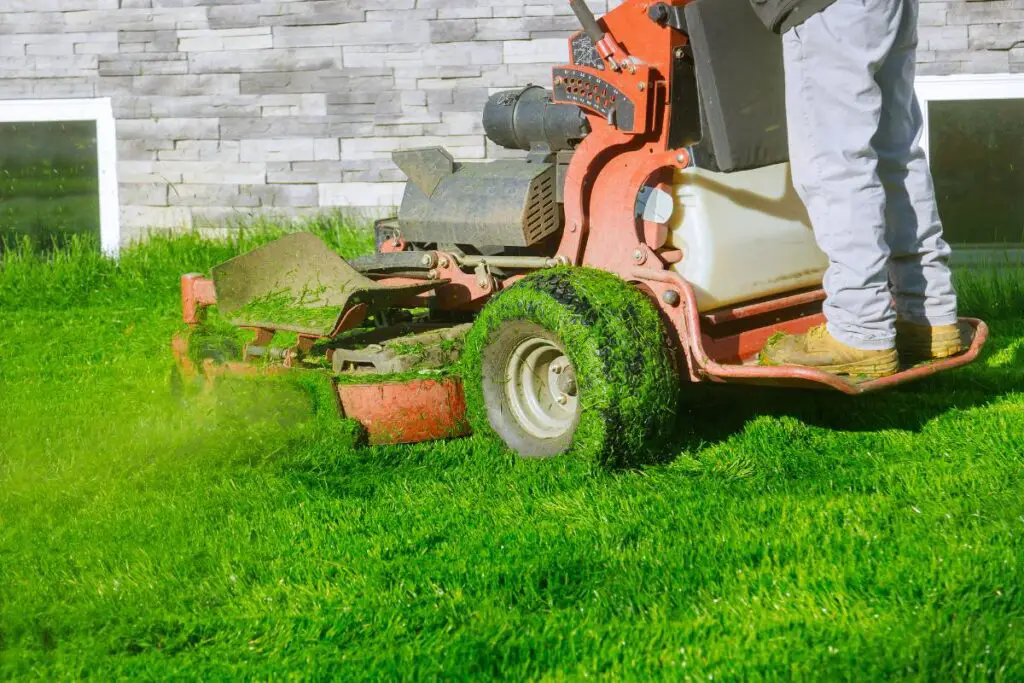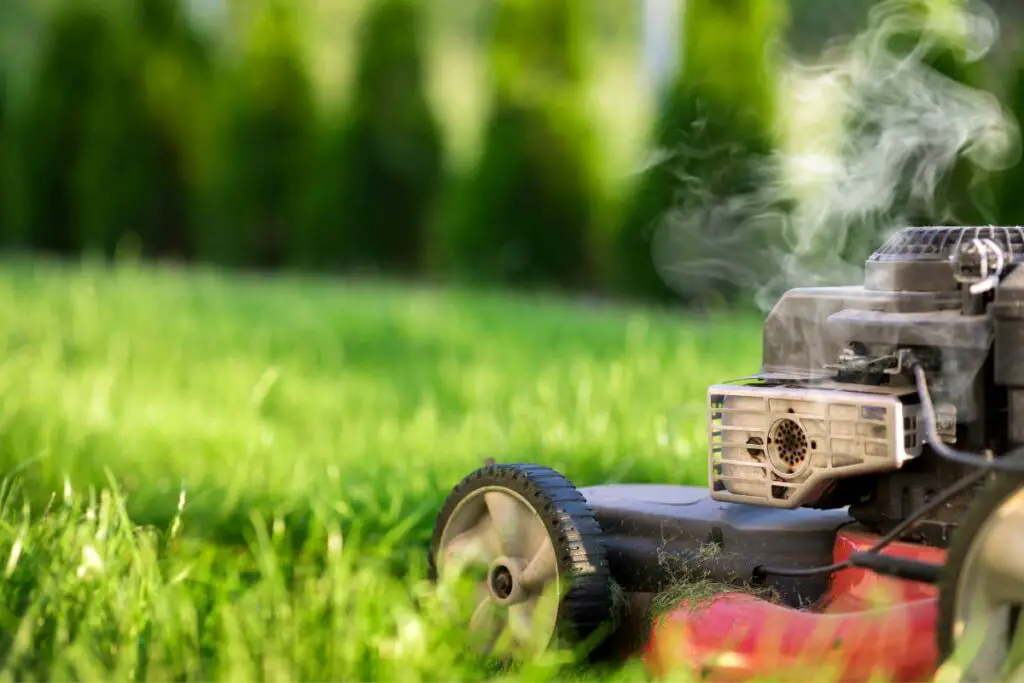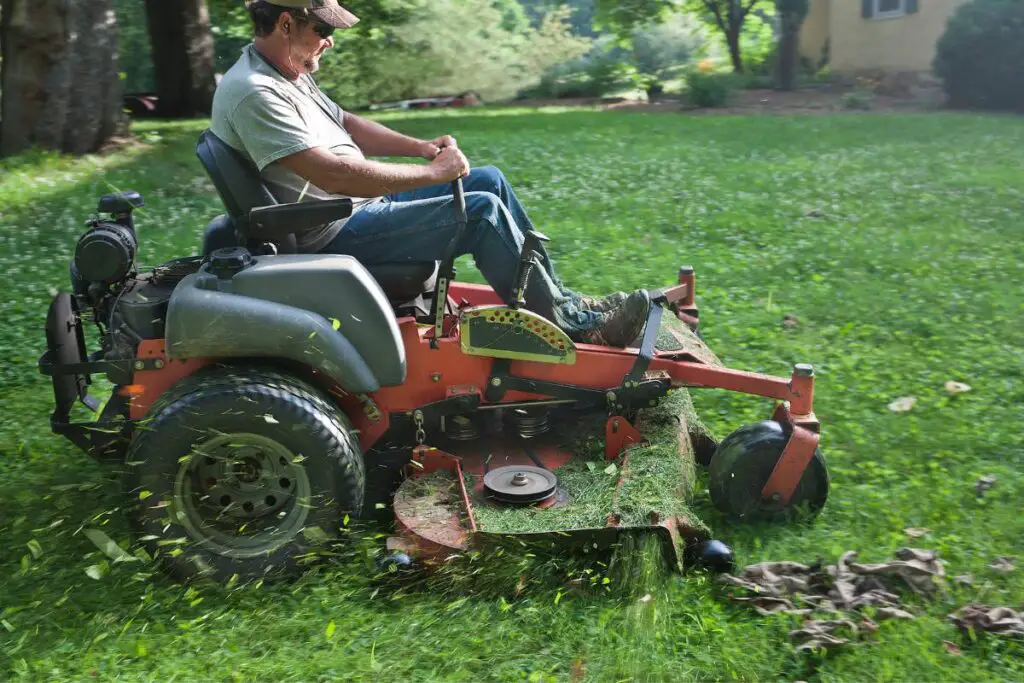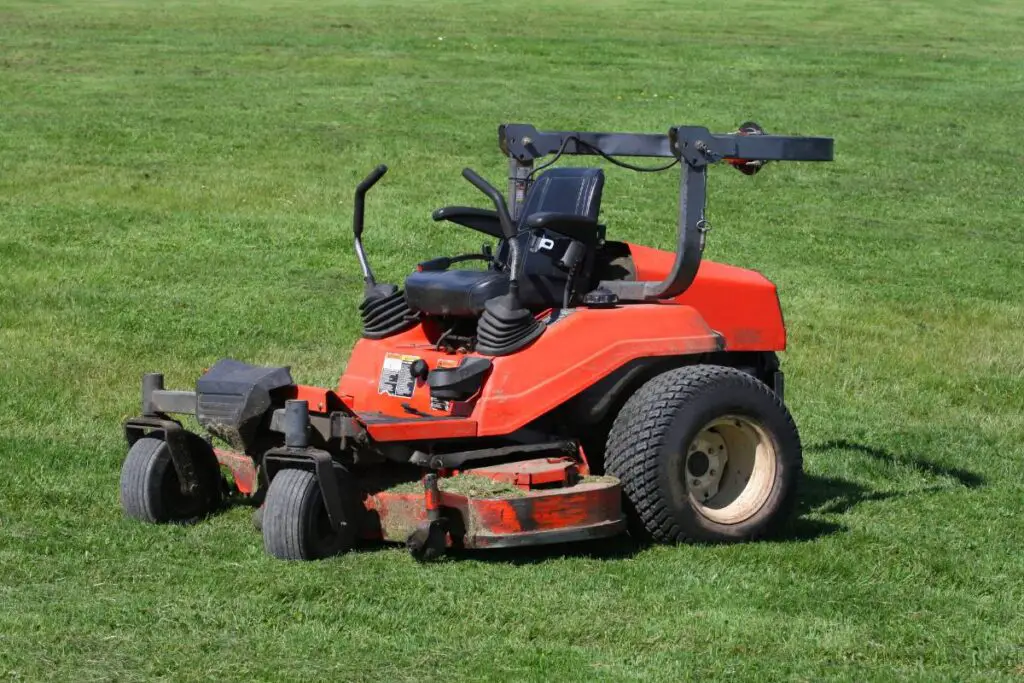You take out the lawn mower to mow your garden but watch the tires go flat. Problems like these can negatively impact the mower’s efficiency. Tires can wear out over time, but if the problem is frequent, you must find the real cause before rushing to change it.
Tires go flat due to rough terrains, heat, punctures by sharp objects, air leakages, and leaky valve systems. To prevent it, check the pressure, replace old tires, avoid using them on rough terrains, park it away from the heat, insert tubes, and buy good-quality tires.
Besides these common reasons, there are a few more behind the problem. In this article, we will answer all the relatable questions regarding flat tires: the reasons, the troubleshooting steps, and ways to prevent flat tires.

Why do lawn mower tires go flat?
The lawn mower tires can go flat once in a while.
They either wear out or get punctured.
But if the wire goes flat frequently, there is something else to inspect.
While puncture and wear and tear are common, beginners do not understand what else to check when the tires go flat too often.
When the tires go flat too often despite the replacement, it indicates a problem that happens most of the time, but you are unaware of it.
So, you need to dig deeper to uncover the real cause behind the tires going flat frequently. Inspect a few more things, for example:
- The terrain
- Sunlight exposure
- The valve system
- Tire wall
- Tire bead and wheel hub bead
- The wheel hub
These are some areas beginners miss checking, and they visit the store straightaway to get new tires.
Identifying some tire issues is challenging unless you carry out an in-depth diagnosis.
With proper inspection, you know how to stop it from occurring further and reduce the chances of flat tires.
Let’s look at all these causes to find out how these make the tire flat and how you can prevent these from happening.
1. Rough lawn terrain
Rough roads and mountains can even flatten car and bike tires.
So, it is essential to consider the terrain condition of your lawn.
If your lawn mower tires go flat frequently after mowing, the reason is rough terrain.
Watch out for ruts, tree stumps, and other debris in the mowing path.
Clean the lawn before mowing, and park the mower over a flat surface.
2. Wear and tear
The old tires are more likely to go flat frequently than the new ones.
You will see frequent punctures in the tire with worn-out treads and sidewalls.
The only solution for this problem is to get new tires for your lawn mower if the present tire has stayed too long.
Use high-quality tires with a longer lifespan.
Also, keep checking the tires’ condition occasionally to spot problems that are likely to cause flat tires.
3. Heat exposure

When you store lawnmowers, make sure to keep them in a cool place.
Exposing them to direct sunlight and heat can make the tires go flat frequently.
When the tires are exposed to heat for too long, the air in the tires keeps expanding.
The more the mower stays exposed to the sunlight, the more the tires expand.
When the air pressure in the tires rises considerably, they will start leaking.
In the worst case, the tire can simply burst out.
So, you must park the mower in a shed away from direct sunlight.
Additionally, the storage place of your mower should be far away from fireplaces, too, because fireplaces also provide the risk of heat.
4. Sharp objects causing tire punctures
It is a common reason behind the flat tires of lawnmowers.
While mowing, the tires can be punctured by sharp objects like broken glass, nails, screws, stones, or pebbles.
The nature of the tire blowout can help you identify the object’s nature.
Sometimes, you cannot understand when the tire gets punctured by a sharp object.
The tire will leak slowly and, after some time, go flat.
A slow leak occurs in the pneumatic tires, which have air without tubes.
Once a sharp object punctures the tire wall, the air mass and pressure of the rubber material will squeeze tightly around the nail, holding and sealing it.
When a sharp object penetrates the tube tire too deep, the tire will immediately go flat because, in these tires, the tube doesn’t seal around the nail like the pneumatic tires.
Check the tires to find the sharp objects, remove them, and replace the tires with new ones. Use good-quality tires that can last longer.
Instead of replacing the tires, another temporary method is fixing the leakage and inflating the tires back.
Once, I visited the lawn mower store, and the staff suggested a heavy-duty tire sealant.
The rubberized glue sits inside the tire and seals the punctures.
Applying the sealant forces it out of the tire when it loses the air and sets to seal the hole.
Another option is to use a professional-grade lawn mower sealant.
Here are the steps to use a sealant:
- Chock the rear wheels and raise them off the ground with a jack.
- Remove the valve cores from the valve stems of the front wheel with a remover tool.
- Find the leakage, take the sealant container, and squeeze it to transfer it into the wheel. Repeat for the other one.
- Install the valve stem cores back into the valve stems.
- Inflate the tires, lower the mower, and remove the chocks.
For the sealant, I use Stan’s Outdoor Tire Sealant, and Flat-Tire Repair, for Outdoor Utility Equipment like Trailers, Wheelbarrows, Handcarts, Golf Carts, and Tractors.
To prevent the problem from further occurring, clean your lawn before mowing.
5. Leaky valve stem
The valve stem helps in inflating or deflating the tires.
Ensure the mower tires have the correct pressure, neither too high nor too low.
The valve can wear out over time and get damaged.
Other causes behind the damage could be corrosion and dirt buildup.
When you discover that the valve stem is the reason behind the flat tires, you should get help from a local service provider or repairer.
To fix the valve stem:
- Deflate the mower tire entirely and remove the valve core.
- Slide the valve hook between the valve’s stem and the opening in the wheel hub.
- Turn the hook to let it hook into the center of the stem.
- Pull the hook from the wheel hub and remove the valve stem.
- Take the valve pusher and connect a new valve stem to the pusher’s shaft.
- Spray some lubricant over the new valve stem and the valve’s opening on the wheel hub.
- Put a funnel into the valve opening over the wheel hub.
- Take the new valve connected to the valve pusher and put it inside the valve funnel.
- Push the valve through the funnel with a pusher and into the valve’s opening.
- Once you have placed the new valve inside the wheel, pull the pusher and funnel until the valve stem’s groove end locks in place.
- Remove the pusher and funnel from the new valve.
- Inflate the tire and install the valve cap. Check the mower for further leaks.
Looking for gardening supplies? We have tested 100's of products before recommending them to you guys. Check out our best pick below:
| Image | Gardening Supplies | Best Price? |
|---|---|---|
 Top
Top Top
Top | Raised Garden Bed Kit | Check On Amazon |
 | XLUX Soil Moisture Meter, Plant Water Monitor, Soil Hygrometer Sensor for Gardening, Farming, Indoor and Outdoor Plants, No Batteries Required | No Results |
 Top
Top Top
Top | 82 Pcs Garden Tools Set and Extra Succulent Tools Set | Check On Amazon |
 | Joeys Garden Expandable Garden Hose with 8 Function Hose Nozzle, Lightweight Anti-Kink Flexible Garden Hoses, Extra Strength Fabric with Double Latex Core, (50 FT, Black) | No Results |
 Top
Top Top
Top | Dual Chamber Compost Tumbler | Check On Amazon |
 Top
Top Top
Top | Sunnyglade Plant Stakes | Check On Amazon |
 Top
Top Top
Top | Organic Cold Pressed Neem Seed Oil | Check On Amazon |
 Top
Top Top
Top | Mighty Mint Gallon :-Insect and Pest Control Peppermint Oil | Check On Amazon |
 Top
Top Top
Top | Scotts DiseaseEx Lawn Fungicide | Check On Amazon |
 Top
Top Top
Top | Jacks Classic 20-20-20 All Purpose Fertilizer | Check On Amazon |
 Top
Top Top
Top | 30,000 Seeds Pollinator Attracting Wildflower Mixture | Check On Amazon |
 Top
Top Top
Top | Survival Vegetable Seeds Garden Kit-Over 16,000 Seeds | Check On Amazon |
6. Air leaks from the valve
The valve inside the valve stem also leads to flat tires.
The valve allows the tires to stay air-filled and prevents the air from escaping.
A valve cover that prevents dirt from entering the valve and blocking it.
Sometimes, these covers can drop off or get lost by mistake when you inflate the wires or break when you cannot get them back over the valve.
If this happens, dirt will enter the valve, and once that occurs, the valve will not close properly, leading to slow air leaks from the tires and making them flat.
To fix the valve core that doesn’t hold air:
- Unscrew and remove the valve core with a valve core removal tool.
- Screw the replacement valve core into the valve stem.
- Inflate the tire and check the mower for leakage.
7. The tire bead and wheel hub bead are not sealed
Several steel wires inside the tire bead provide the bead enough strength and prevent it from stretching after the installation.
There will be another bead on the wheel hub that fits the tire bead.
Once the tire is installed, both these beads will create a tight seal.
Due to this technique, the tires do not require any inner tubes.
If these beads get damaged or obstructed, an airtight seal will not exist.
As a result, the tires will go flat over time.
If the tires are fine, check for this seal and find out whether they are damaged or obstructed.
Replace the beads if they are damaged, and for obstacles, remove the obstructions between the connection point of the two parts.
8. Damage in the wheel hub or imperfect bead seating
Check the actual wheel hub.
The hub and the hub’s bead should be perfectly round.
A deformed front caster wheel will stop the tire from holding the air inside and lead to flat tires.
If the tire bead is not perfectly seating, follow the following steps to seat it correctly:
- Lift the lawn mower to let the flat tire go above the ground.
- Check the tire closely for leakage.
- Remove the valve stem core and connect the tire inflator if there isn’t any leakage.
- Spray the place where the bead is off with a spray lubricant.
- Now, inflate the flat tire again.
- Press, squeeze, or push the tire bead to seal manually.
- Inflate the tire until it reaches the maximum pressure.
- Deflate the fire if the bead is not popping in its place and repeat the process until the tire bead pops into its place.
- Remove the inflator and install the valve core.
- Inflate the tire again to the required pressure.
- Bring down the lawn mower and install the valve cap. Check the mower.
The tire bead will take some time to pop in its place. So, try to use a big tire inflator.
A tire sealant can also work with the rim leaks, provided the leakage is small, and the bead is on the rim.
Also, see whether the wheel of your mower contains any welds.
The inner parts of the wheel hub are welded to the outer rim.
These welds can break and corrode over time, causing air leakages through the rims.
In that case, you need to replace the damaged welds.
Proven methods to keep the lawn mower’s tires from going flat

When you already have a flat tire, you have no other option than to fix it.
But it is better to take preventive measures and keep the tires from going flat.
Here are some ways to keep the lawn mower’s tires from going flat:
1. Check the tire pressure regularly
Checking the tires and the air pressure is an essential step during the maintenance routine.
Always check the tire pressure when you provide regular monthly or weekly maintenance.
The tires can lose air faster despite their size.
If you do not have a pressure gauge to check the pressure, check into the refill station.
If you have a pressure gauge, the gauge must be read both high and low pressure.
Since both can create issues, checking will ensure the tires have the optimal pressure and there is no risk of leakage or burst.
2. Take care of the maximum pressure
The maximum pressure labeling on the tires’ sidewalls does not mean the maximum pressure refill.
The optimal pressure can be lower than the maximum pressure mentioned.
So, while inflating the tires, avoid crossing the maximum limit if you do not want to burst the tire.
3. Replace tires regularly
The tires will become old after regular usage, and the regular wear and tear will make them lose air slowly.
You need to diagnose the tires manually to determine the right time for a change before they become completely flat.
The wear and tear in the tires will occur not only on the treads after years of usage but also on the sidewalls.
To prevent the tires from getting flat frequently, avoid using them over rough terrains, and ignore harsh chemicals when you wash the mower, as they can wear out the tires faster than usual.
Usually, the tire changing frequency is 3 to 5 years. However, the timing can increase or decrease based on how they are being stored.
If you keep them outside, you must change the tires before 3 to 5 years.
If you use low-quality tires, you might have to change them yearly.
4. Park the mower under the shed, away from heat sources
Once you mow, store or park the mower in the shade, away from direct sunlight and fireplaces.
Direct heat can crack the tires’ sidewalls, wire them out faster than average, and leads to fast flattening.
If you do not want to spend extra money every few weeks on the tires, keep them away from heat.
5. Preventing punctures: Cut grass regularly and clean the lawn before mowing
Long grass can create obstacles that you cannot find while mowing.
Due to this, if any sharp objects lay over the ground, they can puncture the tires every time you mow.
But when you mow your lawn regularly, the grass will stay short.
You can see these objects, clear them out of the way, and prevent the tires from puncturing and going flat.
Cutting the grass regularly also allows the mower to mow efficiently and cleanly without issues with the blades and mower decks.
Before you cut the grass, make sure to clean the lawn to get rid of all the sharp objects and prevent punctures.
A clean lawn encourages smooth mowing without any obstacles and reduces the chances of punctures.
6. Insert tubes in the tires of the mower
Tubeless tires are popular nowadays but require high maintenance and costs.
Tubes can prevent air loss.
So, when you do not have them in your mower’s tires, you must be extra careful while mowing.
When the tubeless tubes hit accidentally, there occurs a high risk of puncture and flattening of the tires.
But with the tube tires, you can reduce this risk.
Additionally, tubeless tires can get separated from the rim, reducing air loss.
The tube tires can keep the tires airtight and have an increased lifespan than the tubeless tires.
7. Buy good-quality and original tires
Counterfeit tires are more likely to wear out and damage faster than original, high-quality tires.
The risk increases when you have not yet considered replacing the tires.
So, the best method to prevent the tires from going flat frequently is to buy original, high-quality tires that match the mower’s mowing efficiently.
It should be able to handle rough mowing to some extent, take time to wear out, won’t lose air, and have a prolonged lifespan.
How do I find a leakage in the lawn mower’s tires?
When the tires go flat, punctures and air leakages are common.
But how do you find it beforehand and stop the tires from going flat?
Here is a way to find the leakage.
Pour water and dish soap mixture into a spray bottle. Then, inflate the suspected tire and spray it with the mixture.
Cover the tire, hub, valve stem, and valve with the mixture spray.
If there is a leakage, the mixture will start bubbling.
Air pressure matters: Right lawn mower air pressure

First, understand that the air pressure inside the lawn mower’s tires should be neither too high nor too low.
Both high and low pressures can harm the tires and create several issues.
So, inflate the lawn mower’s tires to the proper pressure.
But the question is, what is the correct air pressure for the mower’s tires?
Determining the air pressure in the mower tires is easy, just like the tires in bikes, airplanes, and cars.
In the tires, spot the labeling Max.Press.XX.
The XX indicates the psi.
Based on the mower’s tire type, the psi can be 30, 34, or 40.
For the worn-out sidewalls, check the mower’s manual for the proper psi for your mower.
You can also find the tire pressure gauges.
To ensure proper tire pressure on your mower, check the psi labeling on the sidewalls of the tires.
Please resist the urge to overinflate them.
We always think that increasing the pressure a bit more will encourage the tires to last longer, which is not true.
Inflating the tires too much can affect the braking threshold, primarily in riding mowers.
It can also increase the chances of a blowout.
Inflating the tires too much can also increase the frequent wear and tear of the lawn mower tires and reduce traction.
Maintenance tips: Practical ways to extend the lifespan of the lawn mower tires
Extending the lifespan of the lawn mower tires is one of the great ways to prevent the tires from going flat frequently.
A good tire can last up to 5 to 6 years.
But the maintenance you provide is what determines the tire’s lifespan.
So, here are some ways to extend the lifespan of the tires:
- Always buy original tires for your lawn mower. If you change the tires for the first time but do not know their features, take it to the market to get the right one.
- Proper mower storage can extend the tire’s lifespan to some extent. Please keep it in the dark, cool shed away from direct sunlight, fireplaces, or areas that can generate heat.
- Proper maintenance is the primary key. If you don’t change the worn-out tires right now, keep the air pressure in check and adequately align it to avoid further wear and tear of the tread.
- Avoid washing the tires with harsh chemicals. Clean water is best.
- Avoid overloading the lawn mower with several tools. It can affect the tires. Every mower comes with a minimal load limit. If you do not know the load limit of your mower, ask your manufacturer.
- Mismatch tires can affect the mower’s performance. When mowing, it feels like the mower walks against the brick walls. This can further affect the tires and reduce their lifespan. If not original, find high-quality tires that nearly match the original ones and have a longer lifespan.
- Keep the tire pressure optimal; neither too high nor too low.
- Rotate the tires after some mileage, for example, 6000 miles.
- Regularly check the tire’s condition so that you can find out the problem beforehand and fix it before the tires go completely flat.
Final thoughts
Tire bursts, leakage, and flattening are some things that you do not want to experience right before mowing or in the middle of the session. So, the best way is to prevent the tires from going flat by keeping them in check and avoiding doing things that can flatten them.
If the tires have already gone flat, the common reasons are rough terrain, heat exposure, punctures by sharp objects, and wear and tear. Other reasons are leaky valve stem, air leaking from the valve, unsealed or misplacement of the tire bead and wheel hub, and damaged wheel hub.
Find out these problems and fix them, as explained in the article. To prevent the tires from going flat frequently, store the mowers in the shed, clean the lawn before mowing, park them over flat surfaces, replace old tires, buy high-quality and original tires, avoid harsh chemicals, check the air pressure and cut the grass regularly, and use tube tires instead.
How much will new lawn mower tires cost?
The cost for the mower’s tires is typically between $25 and $250. But it can vary based on the brand, size, and quality. The four new tires for the lawnmowers can cost nearly $200.
How often should I replace my lawn mower tires?
It depends on how you are using and maintaining it. You can change the tires every 3-5 years. You can wait a few more years if you maintain and keep them in good shape. But, if you store them mostly outside and use them over rough terrains, change them every 1-2 years.
Reference: Lawn Mower Tires Wikipedia
